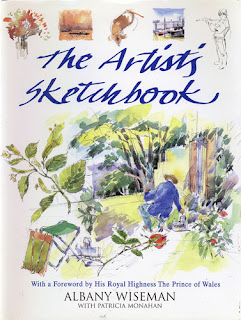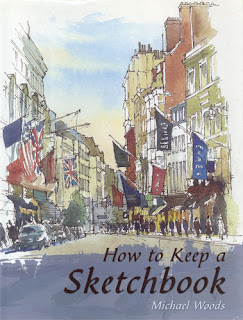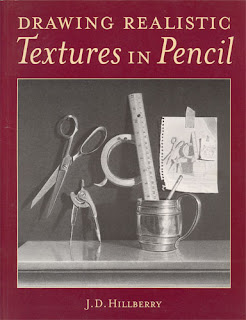 |
Winner of the 2007 Lynn Painter-Stainers Prize
New Life,oil painting
copyright Benjamin Sullivan RP, NEAC (DO NOT COPY OR SAVE TO DISC) |
This year 66 paintings by 62 artists were chosen from some 800 entries (that's just over 8%). They're exhibited on special panels incorporating a lighting system in the Livery Hall and as a result virtually all works have very good lighting. It's an excellent show which includes work in a huge range of sizes and media - oils, watercolours, large pencil drawings, monoprints and tiny works in egg tempera. However there was only one acrylic painting and, sadly, fine art printing (often renowned for draughtsmanship) was also represented by only one work - which won a prize!
You can see the artists whose work was selected for the 2007 Lynn Painter-Stainers exhibition on the Parker Harris website.
The 2007 panel included the following judges:
Other prizewinners are:
 Lady Thatcher in Livery Hall
Lady Thatcher in Livery Hall
9"x6"pencil and coloured pencil in Moleskinecopyright Katherine Tyrrell
For me the exhibition brochure - which includes images of the prize-winning works - would be more helpful if it included a short resume of all prizewinning artists on the almost blank page facing each image, especially as there is an obvious intention to promote this type of artist and art.
Interestingly there is also no website specific to the exhibition - only one run by the people who administer the competition. This means no online images of the prizewinners or any other images from exhibition. I think this is a major omission as I'm sure many artists who might want to submit would really like to see the type of work being shown if they are unable to travel to/see the exhibition. Of course it can also help sales! I have however to thank Parker Harris for very kindly sending me an image of the winning work for this blog post. I trust this now conveys rather better than my prose why this painting deserved to win.
- Artists Ken Howard RA, RWS, NEAC, RWA, ROI, RBA, RBSA, ARCA, (Past President of the New English Art Club, Daphne Todd OBE PPRP NEAC HON HON SWA (Past President of the Royal Society of Portrait Painters) and James Lloyd (who won the BP Portrait Prize in 1997 and is my 'drawing a head' class tutor),
- Gallery owner: Francis Kyle
- Visiting Research Fellow at Tate Britain and art historian: Andrew Wilton
- Art Critic for The Spectator Laura Gasgoigne (do read her article on the exhibition which describes the selection process. What happens will come as no surprise to anybody who has ever been involved in a selection process for an exhibition or competition attracting a large number of entries - but maybe a bit of an eye-opener for others).
At the end of this savage exercise in speed-rating, what are we left with? A remarkably representative overview of the varied state of British representational painting. In the still-life camp, Uglowish lemons and Morandiesque garlics vie with photorealist crushed drinks cans and plastic bags. On the landscape front, a Cornish beach scene with echoes of Alfred Wallis sits alongside a snowy back garden à la Carel Weight and a super-realist 1960s motorway restaurant. There are odd images of animals and children: a mad-eyed Albino hamster presses his quivering pink nose against a picture plane, while a small boy in blue underpants skips over a telly. In the portrait department — heavily subscribed this year — there are paintings of young and old by young and old, the age not always reflected in the price: a giant Lady Thatcher by 25-year-old Lorna May Wadsworth carries a gob-smacking price tag of £100,000. (Only a maniac would pay that, but perhaps one will.)The winner of the Lynn Painter-Stainers prize ( of a gold medal and £15,000 /$31,000) is Benjamin Sullivan RP, NEAC with a work called 'New Life' which is a curious - and very fine - portrait of a woman in a dressing gown, with a cat and a mouse and a self portrait of the artist above a separate painting of the view of the backs of some houses. Sullivan has a fine art degree from Edinburgh College of Art and is a member of both the NEAC and Royal Society of Portrait Painters and has won several awards with both art societies.
In short, this year’s Painter-Stainers is a massed parade of painterly observation of a sort too rarely seen in public galleries.
Laura Gasgoigne, The Spectator Art column
Other prizewinners are:
- The Young Artist Prize (£2,500) Poppy Jones 'These Screen' - a monoprint (she is yet another fine art graduate of Falmouth College of Art - whose ex students also did very well in the ING Discerning Eye competition). The Young Artist Award is for an artist who is 25 years of age or under on 3 September 2007.
- Runner Up (£1,000) Dick French The tunnel of love - pencil and oil pastel and paper collage
- Runner Up (£1,000) Jennifer McRae - Lord Slynn of Hadley and the sea holly - oil (I continue to be intrigued by her technique and skill. Jennifer McRae has also won first prize in The Hunting Art Prize in 1998 and has works in the National Portrait Gallery, and Scottish National Portrait Galleries.)
- Runner Up (£1,000) Susan Wilson - The Young Oxford Undergraduate - oil (a New Zealand artist who studied at Camberwell and the Royal Academy and who now lives in the UK. She taught at Chelsea School of Art from 1988-93.)
- Runner Up (£1,000) Neale Worley NEAC - Andrea - oil (He is a member of the NEAC and has won previous prizes with them)
- Runner Up (£1,000) Antony Williams RP - Emma with cactus - egg tempera. (This is a simply HUGE painting to be in egg tempera. Think millions of brush strokes! He is a member of the Royal Society of Portrait Painters and exhibits regularly in the BP Portrait Awards and RA Summer Exhibitions. He also has works in the National Portrait Gallery and Queen’s College Oxford.)
I work almost exclusively in egg tempera, which can be a painstaking and exacting medium, but one which allows me to express a feeling I have about the look of the world. All my work is the product of direct and intense observation,which can produce as a result a heightened sense of realism,where every surface detail is given almost equal consideration.I sketched one end of Livery Hall - which included the absolutely enormous oil painting of Lady Thatcher by Lorna May Wadsworth priced at £100,000. I distinctly remember being puzzled when looking at this, as I didn't quite understand how the 'drippy' background and style of painting matched the character of the woman. Apparently Sir Denis Thatcher was a member of the Painters-Stainers Company.....
Antony Williams RP - see examples of portraits here
 Lady Thatcher in Livery Hall
Lady Thatcher in Livery Hall9"x6"pencil and coloured pencil in Moleskinecopyright Katherine Tyrrell
For me the exhibition brochure - which includes images of the prize-winning works - would be more helpful if it included a short resume of all prizewinning artists on the almost blank page facing each image, especially as there is an obvious intention to promote this type of artist and art.
Interestingly there is also no website specific to the exhibition - only one run by the people who administer the competition. This means no online images of the prizewinners or any other images from exhibition. I think this is a major omission as I'm sure many artists who might want to submit would really like to see the type of work being shown if they are unable to travel to/see the exhibition. Of course it can also help sales! I have however to thank Parker Harris for very kindly sending me an image of the winning work for this blog post. I trust this now conveys rather better than my prose why this painting deserved to win.
Finally, in location terms, Painters Hall is 'off the beaten track' in terms of main City of London thoroughfares but is just around the corner from Mansion House tube and is walking distance of the centre of the City of London. I noticed that the location of the exhibition - or maybe the size of the prizes(?) - appeared to have had a huge impact on prices of paintings - which seemed to me to be very much higher than those seen in the Mall Galleries or the NEAC website for work by the same artist.
A couple of things occurred to me afterwards.
Given the obvious weighting towards portraits in terms of both submissions and prize-winners, I wondered whether judges are announced before the submission deadline - and whether that choice then effectively acts as a filter on which artists apply or what sort of work they submit. One wonders whether it is any coincidence that there were so many portraits this year given Daphne Todd's presence on the panel at the same time as one of the other artists is a prize-winning portrait painter and the third is a renowned figurative painter. Although I didn't enter I did look at the details when they came out and do remember immediately thinking 'portrait' as to the type of work to submit. So is the choice and mix of judges a deliberate act on the part of the organisers or entirely coincidental or what?
It then struck me that I'd also seen a lot of good work at this exhibition and the ING Discerning Eye exhibition last week by people who weren't apparently members of (national) art societies. I wondered why so many up and coming artists choose to submit to exhibitions like these rather than the (national) art societies? However my perception of this was in part dictated by the fact that the Lynn Painter-Stainers catalogue omitted to recognise various artists' memberships of various art societies. It gives the impression that only three are members whereas in fact a number of them have memberships of one or more societies. I checked with the entry form and it doesn't ask for this information - which is unusual as most do. However, notwithstanding this, although I recognised some artists' names and their work, there were a lot of artists were showing work new to me at both exhibitions - although much more so at ING Discerning Eye.
So are artists willing to submit to major prize competitions but not the open exhibitions held by the art societies? I certainly detected a different 'flavour' to the ING and Lynn Painter-Stainers. Although I know costs deters a lot of artists who have to ship from outside London, I don't think the reason can be cost as this seemed to be similar in cost to the RA and those, for example, operating out of the Mall Galleries. Maybe there is a perception that the selection process of the art societies tends to favour members and friends of members? It then struck me that none of the art societies actually explain their selection process anywhere on their websites. In terms of details which have got into the public domain, it's taken television and two journalists (the BBC with the RA Summer Exhibition, Lynn Barber last year with the Turner Prize and Laura Gasgoigne with this Prize) to explain what actually happens. Maybe more transparency about such matters might attract even more entries.? Personally, I think that if societies said more about the process and the chances of non-members being selected then that might well make a difference and benefit both artists and exhibition.
What do you think?
- Does a major prize competition/exhibition make a difference to whether or not you submit?
- Should societies and competitions be more explicit about the process they use for selection?
- Or are there other reasons?
If you think you might be interested in applying in future years here are a few details which related to this year's competition. You can find more information here.
- The Lynn Painter-Stainers Prize is open to living artists over the age of 18 on 3 September 2007, who are resident in the United Kingdom, Channel Islands or Isle of Man.
- Only original, two-dimensional works in any painting media, that have been completed in the last three years, and that have not been previously exhibited, are eligible.
- All works must be for sale, except commissioned portraits.
- Artists may submit up to two works.
- Works of art submitted must not exceed 72 inches (183cms) in their largest dimension including frame.
- Works on paper must be framed.
(1) The Worshipful Company of Painter Stainers
Formed in 1502 by the amalgamation of companies in existence before 1283. Originally the Painters applied colour to solid materials such as stone, plaster, wood or metal and the Stainers applied colour to woven materials such as canvas. Over the years the Company became more involved with Fine Art whilst still carrying out decorative work to buildings and ceremonial flags and banners. The Worshipful Company of Painter- Stainers is actively engaged in supporting the art and craft of painting. With a strong commitment to fine art, the Painters’ Company Charity is delighted to sponsor this annual prize in conjunction with the Lynn Foundation.
(2)The Lynn Foundation
The Lynn Foundation is a registered charity devoted to children, the disabled, music and the arts. Its contribution as co-sponsor with the Painter-Stainers is the prize money totalling £22,500 and an engraved gold medal for the winner.
(3) This year the Prize has also been supported by Linklaters, the Crown Group and The Spectator.
Links:













